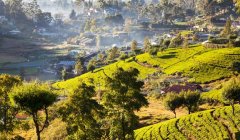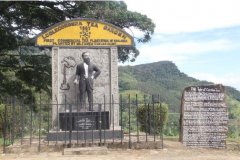Why is Sri Lankan Ceylon black tea the cleanest in the world? How much is a cup of Ceylon black tea?
With the phase-out of methyl bromide, a pesticide widely used in tea cultivation that is harmful to the ozone layer, now is the perfect time to enjoy a refreshing and ozone-friendly cup of Ceylon tea. A long-term study aimed at improving the environmental sustainability of the Sri Lanka tea industry has borne fruit, with Sri Lanka tea farmers receiving the world's first "ozone friendly" status for stopping the use of methyl bromide as a pesticide in their local tea plantations. Methyl bromide is a colorless, odorless gas that has been used in agriculture since the 1930s as an effective fumigant to kill weeds, fungi, insects and worms. Methyl bromide has been used by tea farmers in Sri Lanka since 1965 to prevent a number of diseases and pests affecting tea plants. Its negative effects on the ozone layer had been recognized as early as the 1980s, and since the shrinking ozone layer threatened the future of all life on Earth, the immediate cessation of the use of ozone-depleting substances had become a top priority for the world's industrial and agricultural sectors.

Sri Lanka had become a signatory to the Montreal Protocol in 1989 and was required to completely phase out the use of methyl bromide in agriculture, including tea cultivation, by 1 January 2015. The Ceylon Tea Council, which is the trustee for all Ceylon tea, has successfully developed an ozone-friendly alternative to methyl bromide in cooperation with other government organizations, Ceylon tea manufacturers, tea exporters and local and international scientific communities and international donors. The Sri Lanka Tea Research Institute, under the guidance of the Ministry of Environment and with the help of Sri Lanka tea farmers, successfully introduced chemical and non-chemical alternatives to methyl bromide, and the country successfully stopped using methyl bromide and celebrated in May, 2011, with the launch of the "ozone friendly pure Ceylon tea" logo, all Ceylon tea brands on the market. In a world constantly seeking to maintain environmental sustainability, this logo proved to be an important value-added certification for the world's best tea brands, dominating the $1.5 billion market. In addition to phasing out toxic pesticides, Sri Lanka tea manufacturers are also seeking to reduce the carbon footprint of tea production by reducing energy consumption and choosing solar energy solutions. Mainly in Sri Lanka tea production in cooperation with government and NGOs has also launched a series of initiatives under the slogan "Eco-friendly tea plantations" seeking to reduce the use of fertilizers and pesticides to protect the biodiversity of Sri Lanka camellia gardens and in the water of these tea plantations and their surrounding resources. With the improvement of the environmental conditions of Sri Lanka tea plantations, brewing a fresh cup of tea is an unprecedented pleasure for eco-conscious tea lovers.
Important Notice :
前街咖啡 FrontStreet Coffee has moved to new addredd:
FrontStreet Coffee Address: 315,Donghua East Road,GuangZhou
Tel:020 38364473
- Prev

Which country is Sri Lanka closest to? How long will the boiled Ceylon tea last?
Really watch one of the world's best thriller writers witness the rise of the Ceylon tea industry and the lush Ceylon tea plantation station in Sri Lanka to witness a group of indomitable courage to develop tea planters and choose to grow tea. throw lemons in life. The first tea garden in Sri Lanka was founded by Jen, a Scot.
- Next

Why is Sri Lanka called James Taylor, the father of Ceylon black tea and the story of planting history?
The historical heritage and success story of Sri Lankan tea (known as Ceylon tea for generations) is unique. The story of Ceylon tea began more than two hundred years ago, when the country was still a British colony. In 1824, a tea tree was brought to Ceylon from China by the British and planted in the Emperor of Peradinia.
Related
- Brazilian coffee yellow bourbon brewed flavor characteristics and origin share! What grade is red bourbon coffee?
- How to judge the roasting degree/concentration/filtration method of coffee beans from the color of coffee soup? What is the difference between dark and light roast coffee?
- Why are the coffee in some coffee shops not enough after being frozen? What should I make up for my American latte cappuccino coffee after being frozen?
- How much water does it take to steam coffee by hand? Why is the coffee brewing and steaming time 30 seconds? What is the purpose of steaming coffee?
- The suspected drink contains too much caffeine! Overlord Tea Lady responds urgently!
- Starbucks rejects antique paper coupons?! Netizen: Missed marketing opportunities!
- What ratio of water temperature and ground does the smart cup method use to press coffee? The difference between brewed coffee and filtered coffee?
- What is the standard process for the purpose of coffee cup testing? What is the difference between hand-brewed coffee and cup testing?
- How to use hand-brewed coffee paragon small golden balls? How does cold coffee lock in the aroma of coffee?
- Is American coffee black? What is the difference between American coffee and drip coffee?

